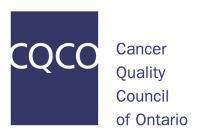Latest Cancer System Index Indicates System Alignment in the Northwest
by Sara Chow
 Cancer Quality Council of Ontario
Cancer Quality Council of OntarioThis year the annual release of the Cancer Quality Council of Ontario’s Cancer System Quality Index provided more encouraging information for Regional Cancer Care Northwest at Thunder Bay Regional Health Sciences Centre (TBRHSC). The interactive tool, which is used to measure performance of the cancer system in Ontario, ranked Regional Cancer Care Northwest as numbers two and one, respectively, in PET/CT utilization and treatment of lung cancer according to guidelines.
“These high-ranking indicators are encouraging right now because in recent years TBRHSC became a Designated Thoracic Surgery Centre and, of course, the connection between the PET utilization and our ability to create isotopes with our very own cyclotron,” said Dr. Mark Henderson, Executive Vice President of Patient Services at TBRHSC and Regional Vice President of Cancer Care Ontario.
In recent months a lot of build-up has been generated about the cyclotron and what it means to have more accessible isotopes to use for a diagnostic test like the PET scanner. One of the biggest impacts will be for patients who are being investigated for suspected lung cancer because a PET scan is an important diagnostic tool for this particular cancer. Having readily available isotopes means that there will be fewer delays and shorter wait times for patients who are waiting for a diagnosis.
Dr. Ken Gehman, Surgical Oncology Lead for Regional Cancer Care Northwest, notes that, with respect to lung cancer, the regional cancer program has been focusing on coordinating care to help enhance lung cancer staging and diagnosis. “In Northwestern Ontario we have developed and initiated a Diagnostic Assessment Program which enhances diagnosis to early treatment, and as part of this we have enhanced access to staging with PET scanning at home. This has resulted in a substantial improvement in time to diagnosis, and consequently, time to treatment.”
Henderson added, “There is some satisfaction and peace of mind knowing that since we are doing so many PET scans in our region that we will be able to sustain them with the work of our scientists at the Thunder Bay Regional Research Institute. In terms of our use and need for this type of diagnostic test, our program seems to be aligning nicely and we’re proud of it.”
The other indicator where Regional Cancer Care Northwest ranked number one was the percentage of colorectal cancer patients with at least one colonoscopy following diagnosis with colorectal cancer within 18 months after initial surgery. However, when this indicator is taken into context with some of the lowest ranking indicators, such as percentage overdue for colorectal cancer screening, cervical screening (Pap test) participation rate, and breast screening participation rate, there is an important issue that comes to light – we are improving our treatment of cancer, but we are not preventing it very well.
“This is not a new issue in our region. We are working hard to make cancer screening more accessible, but we also need people to book their appointment and complete their screening test” says Henderson.
Each year the Cancer System Quality Index helps to guide Regional Cancer Care Northwest to make practical improvements that have a positive impact. This year the alignment between the PET scanner utilization, the cyclotron and TBRHSC’s increasing ability to treat lung cancers is a great way to build more momentum in providing exceptional cancer care close to home.
Media contact:
Sara Chow
Health Promotion & Communications Planner
Prevention & Screening Services
Thunder Bay Regional Health Sciences Centre
(807) 684-6716
chows@tbh.net